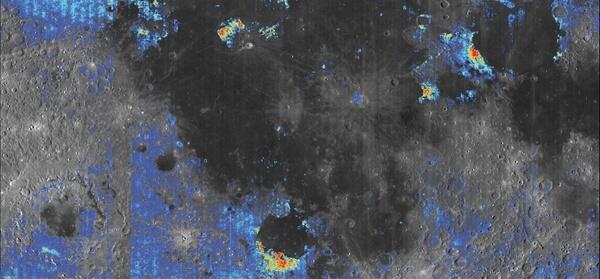While there are plenty of features dubbed “seas” on the Moon, none of them ever contained watery depths. For decades, scientists believed this was also true of our satellite’s interior — based on our theories of the Moon’s formation, its mantle should contain little water. However, a new study indicates that the Moon’s mantle may be more water-rich than we thought.
The study, published today in Nature Geoscience, was carried out by Ralph Milliken, an associate professor in Brown’s Department of Earth, Environmental and Planetary Sciences, and Shuai Li, a recent Brown graduate now working as a postdoctoral researcher at the University of Hawaii. They began seeking a way to more accurately measure the water content of the Moon after studies performed in 2008 and 2011 found traces of water in lunar samples returned to Earth on the Apollo 15 and 17 missions. Based on the amount of water in the samples, which was comparable to the water content of basalts on Earth, planetary scientists calculated that parts of the Moon’s mantle could contain similar amounts of water — much more than previously thought.
But because we have such limited samples of lunar rock from only a few landing sites, it was unknown whether the Apollo mission samples were unique. “The key question is whether those Apollo samples represent the bulk conditions of the lunar interior or instead represent unusual or perhaps anomalous water-rich regions within an otherwise ‘dry’ mantle,” said Milliken in a press release.
Thus, the team turned to orbital data taken with the Moon Minerology Mapper, an instrument on the Indian Space Research Organisation’s Chandrayaan-1 lunar orbiter, to deconstruct reflected sunlight from the Moon’s surface. Specifically, they looked at large-scale volcanic deposits called pyroclastic deposits, which brought material from deeper within the Moon to its surface. These deposits were not sampled by the Apollo astronauts. By studying the reflected light from these areas, the team aimed to determine the makeup of the material and look for water.
But there was a snag — the wavelengths at which water can be detected are also the wavelengths affected by heating as sunlight strikes the Moon. “So in order to say with any confidence that water is present, we first need to account for and remove the thermally emitted component,” Milliken explained.
That required the pair to understand and model this heating. To accomplish this task, Milliken and Li used the existing Apollo samples in combination with additional data on the heating experienced by the Moon’s surface to remove this component from the Chandrayaan-1 readings.
Once the heating was removed, the team found evidence for water in almost every volcanic deposit they studied, including sites located near where Apollo 15 and 17 touched down. “The distribution of these water-rich deposits is the key thing,” Milliken said of their finding. “They’re spread across the surface, which tells us that the water found in the Apollo samples isn’t a one-off. Lunar pyroclastics seem to be universally water-rich, which suggests the same may be true of the mantle.”
If that is true, it might require us to tweak our theory of the Moon’s formation. Previously, the Moon was not thought to contain a significant amount of water because the collision that created it should have been hot enough to destroy the hydrogen required to form water as the debris condensed into our satellite.
However, the new finding does not discredit this theory. “The growing evidence for water inside the Moon suggest that water did somehow survive, or that it was brought in shortly after the impact by asteroids or comets before the Moon had completely solidified,” said Li. “The exact origin of water in the lunar interior is still a big question.”
Source: http://bit.ly/2usYhda











